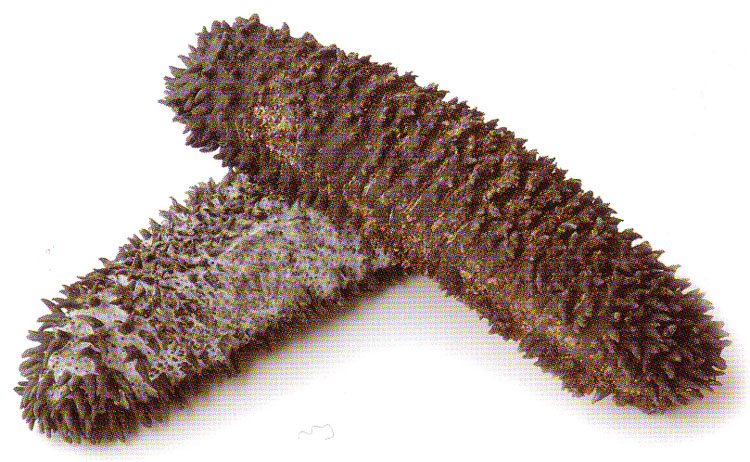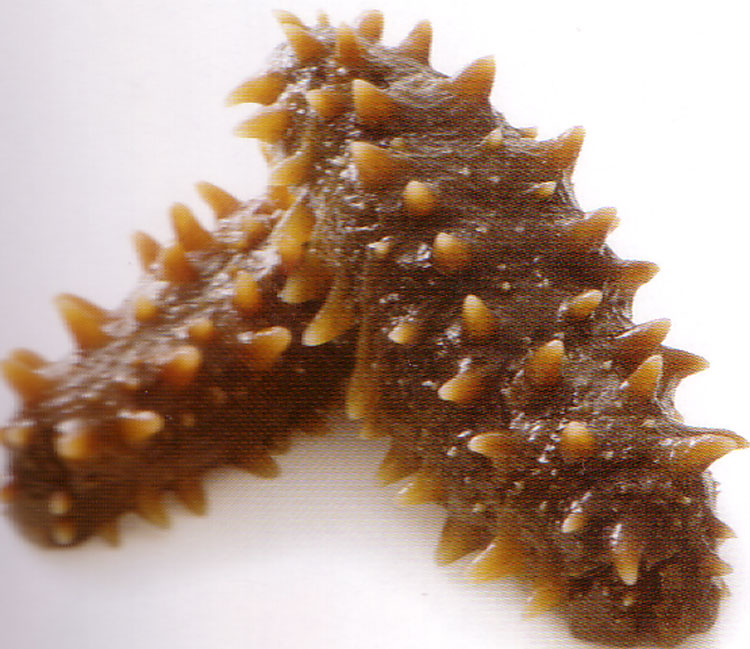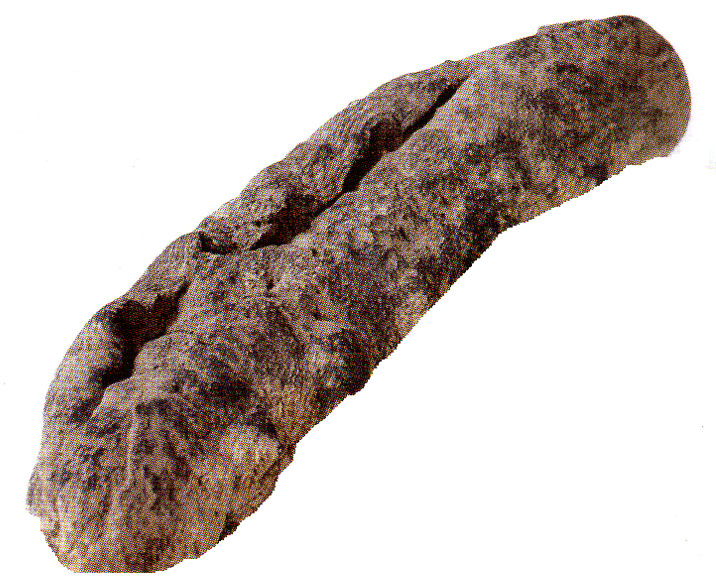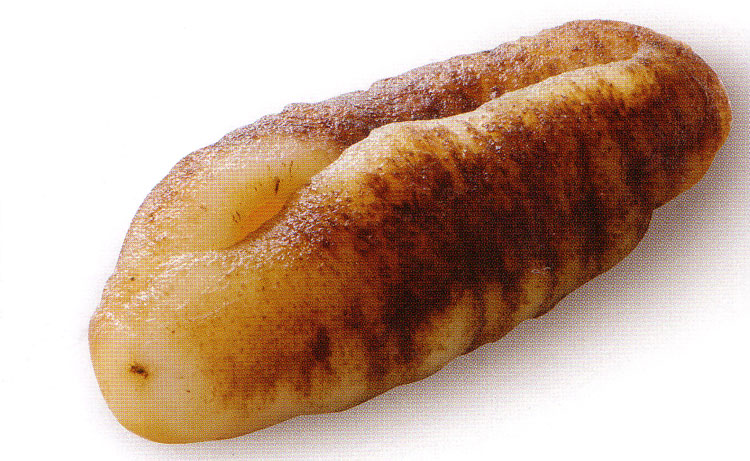
| What is Flavor and Fortune? |
| How do I subscribe? |
| How do I get past issues? |
| How do I advertise? |
| How do I contact the editor? |
Read 7001524 times
Connect me to:
| Home |
| Articles |
| Book reviews |
| Letters to the Editor |
| Newmans News and Notes |
| Recipes |
| Restaurant reviews |
| Article Index (all years, slow) |
| List of Article Years |
| Article Index (2024) |
| Article Index (last 2 years) |
| Things others say |
| Related Links |
| Log In... |
| Authors |
| Categories & Topics |
Sea Cucumber
| by Jacqueline M. Newman |
Unusual Ingredients
Winter Volume: 2011 Issue: 18(4) page(s): 7, 8, and 29
This echinoderm is related to the star fish and the sea urchin, and has, like many other plants and animals on land and in sea, many names. A more acceptable name on the European continent and in France is to call them 'bêche de mer.' In the United States, technocrats call them 'trepang,' most fishermen call them 'sea slugs,' and you may have heard them referred to as 'sea rats.' The Japanese call them namako which translates to 'sea mice' and some Chinese do call them 'ginseng of the sea. Should you wonder why this Chinese name, it is because they believe they have medicinal properties, as does ginseng.
Information about sea cucumbers was written about in Volume 2(3) on page 10, and in Volumes 14(2) and 14(4) on pages 16 and 9, respectively. However, never has an entire article focused on this one very well-regarded food item.
Visually, there are spiny ones and smooth ones, shown in that order, and they are commonly purchased dried, as is one of each shown on this page, also soaked. The illustrations are but four of the many kinds of these sea creatures.
Usually found at the bottom of the sea, these are reasonably sedentary animals that protect themselves giving off a toxin, some say similar to soap. The difference is, however, this toxin can kill an animal in its vicinity. These sea creatures, when ready for consumption and also when simply soaked, are gelatinous. Alive, they tend to be found in groups, some do float on or near the water's surface, others can be well below its surface.
Full-grown, sea cucumbers are three to ten inches long and one to two inches wide. They are scavengers that eat lots of plankton and decaying organic matter. They breathe in oxygen from the water, then expel it.
Sea cucumbers of all types are used as food in China, in the rest of Asia, and in many other countries. Aside from their culinary uses, they are used in oils and creams and in other cosmetic applications. Research about them supports their use as pain relievers, in other medications, for tissue repair, and in anti-malarial medications.
Sea cucumbers were written about in the Chinese Canon of Gastronomy in the 5th to 6th centuries CE. There, they were called hai shu. In a modern dictionary, one more commonly finds them called hai shen or hoi sam.
Not limited to Asia, hundreds of varieties of sea cucumbers swim all over the world, in both warm and cold waters. As already mentioned, they are found with a prickly exterior also called a spiny one, and with a smooth exterior; and they can be black, brown, dark tan, medium tan, and a few are actually light tan.
In the Pacific, one finds the Stichopus species of the family Holothuriodea. These and others in the Atlantic are popularly consumed at New Year celebrations. One ancient Confucian recipe, called Eight Immortals Crossing the Sea, uses them with shark's fins, ginseng, cordyceps, and tremella. Together, the foods in this recipe are holiday wishes for longevity and disease prevention. During Confucian times, they were also known as fang ci shen or fang shen. These particular names call attention to those with a four-sided thorny exterior.

 Not only popular during the Spring Festival, as the New Year holiday is also known in China and by Chinese world-wide, there is great demand for these sea animals in Asia, Europe, and elsewhere. In Atlantic waters, they are commonly known botanically as Cucumaria frondosa. All over the world, they are known for their medicinal uses, their holiday uses, and their historical uses.
Not only popular during the Spring Festival, as the New Year holiday is also known in China and by Chinese world-wide, there is great demand for these sea animals in Asia, Europe, and elsewhere. In Atlantic waters, they are commonly known botanically as Cucumaria frondosa. All over the world, they are known for their medicinal uses, their holiday uses, and their historical uses.
Chinese, Japanese, and Russian studies report their saponin or tri-terpene glycosides have a structure similar to the active components in both ganoderma and ginseng. These structures make them loved for their anti-cancer and anti-inflammatory properties. They are also used as HIV therapy, as herpes virus inhibitors, and as long-chain sulfated polysaccharides that are chondroitin-building-block medications.
For use in the kitchen, many cooks prefer to purchase them dried while others buy theirs soaked and soft. The latter way they are mostly found in Chinese and other Asian markets. For those who do buy them dry, the recommendation is to soak them in cold water overnight, discard that water, add fresh cold water, and bring that to the boil for half an hour or more. When cooking is completed, cover them and let them cool.

 The above recommendation says to repeat these two things often, sometimes needing many repetitions for as much as two to four days until they are nice and soft. When very soft, discard their intestines and any other innards, then use them in a recipe. Want to speed up this process, after one or two days of soaking, put them in fresh cold water, simmer for three hours, allow to cool, take out their innards, and touch them in many places being sure they are soft and pliable.
The above recommendation says to repeat these two things often, sometimes needing many repetitions for as much as two to four days until they are nice and soft. When very soft, discard their intestines and any other innards, then use them in a recipe. Want to speed up this process, after one or two days of soaking, put them in fresh cold water, simmer for three hours, allow to cool, take out their innards, and touch them in many places being sure they are soft and pliable.
Before providing recipes using sea cucumbers, you might want to know that the Chinese believe they nourish one's qi and improve one's blood. They also tonify the kidney and reproductive organs and moisten the intestines. Traditional Chinese Medical practitioners (TCM doctors) recommend them for general weakness, to reduce frequent urination, reduce impotence, and aid general debilitation of the aged; also to increase yin and yang energy, regulate menstruation, nourish the fetus, and facilitate labor.
These TCM doctors like them used in a soup with tremella or cordyceps which will nourish yin and yang. Another recommendation is to cook them with lamb, especially from older animals, or to prepare them with pork or ham.
Sea cucumber is high in protein, has many polysaccharides, is low in fat, and helps build cartilage. For those that do not like its gelatinous texture, the only suggestion is to purchase this food/medicinal as capsules or as pills. In any form, the Chinese believe they reduce pain from arthritis even if taken in amounts as small as half teaspoon each day.
| Sea Cucumber for Soup |
|---|
1 to 2 soaked sea cucumbers 2 cups chicken broth 1 Tablespoon rice wine 1 scallion, tied in a knot 3 slices fresh ginger 1 chicken thigh, blanched in boiling water for two minutes, then discard the water Preparation: 1. Put sea cucumber in two cups chicken stock. Add the rice wine and the scallion, and the fresh ginger slices. Bring to just below the boil, and simmer covered for one hour. 2. Add the blanched chicken thigh and simmer until the sea cucumber is very soft before removing the sea cucumber and the chicken. Set them aside. Remove the scallion and the ginger and discarding them. 3. Cut the chicken and the sea cucumber into half-inch cubes, and use them in the broth as a soup, or put them and their liquid into another prepared soup, heat, and serve. |
| Sea Cucumber in Brown Sauce |
|---|
1 Tablespoon lard 4 scallions, trimmed and angle sliced 4 slices fresh ginger, peeled and slivered 4 prepared soft sea cucumbers; follow the Sea Cucumber for Soup recipe then separate the liquid from the solids 1 Tablespoon rendered chicken fat 1 teaspoon sesame oil 1/4 cup thin soy sauce 1 Tablespoon Chinese rice wine 1 teaspoon sugar 1 Tablespoon and 1 teaspoon Chinese sweet flour sauce 3 Tablespoons cornstarch mixed with three tablespoons cold water Preparation: 1. Heat the lard in a wok or fry pan, add scallions and ginger and stir-fry for one minute, then cut and add the sea cucumber pieces and stir-fry another two minutes before adding the chicken fat, sesame oil, soy sauce, rice wine, sugar, and the sweet flour sauce. 2. Stir this for one minute, then add the liquid from the Sea Cucumber for Soup recipe and the chicken pieces and bring to the boil, reduce the heat, and simmer for ten minutes. 3. Stir the cornstarch mixture, and simmer until the sauce thickens, then serve. |
| Sea Cucumber with Vegetables |
|---|
1/2 cup vegetable oil 20 wonton wrappers, sliced into thin strips 4 soaked soft sea cucumbers, innards removed and discarded. each cut into half-inch pieces 2 scallions, cut into one-inch pieces 5 slices fresh ginger, peeled 1/4 cup canned bamboo shoots, drained and sliced 1/4 cup canned straw mushrooms, each cut in half 1/4 cup sliced baby bok cai 3 Tablespoons thin soy sauce 1 Tablespoon rice wine 1 teaspoon sesame oil 1 teaspoon sugar 1/2 cup chicken stock 4 Tablespoons cornstarch mixed with four teaspoons cold water Preparation: 1. Heat vegetable oil in a wok or fry pan and fry the wonton strips, continually stirring them until they are tan and crisp, then remove from the oil and drain them on paper towels before putting them all around the outside two or three inches of a large deep platter. 2. Add the sea cucumber pieces to the wok and fry for two minutes, then remove them to paper towels. 3. Add scallions and ginger to the remaining oil in the wok and stir-fry them for one minute, then remove them and add them to the sea cucumber pieces. 4. Add bamboo shoots, straw mushrooms, and the bak cai into the wok and stir-fry for two minutes before draining and putting these vegetables together with the sea cucumber pieces. Next discard all but one tablespoon of the oil. 5. Reheat the tablespoon of the oil, add the soy sauce, rice wine, sesame oil, sugar, and the chicken stock and bring to the boil. Return the scallions, ginger, all the vegetables, and the sea cucumber to the wok and stir, then allow to boil for one minute before adding the cornstarch mixture. Stir as it boils, and when thickened, pour this onto the platter leaving one inch of the fried wonton strips without any sauce mixture, then serve. |
| Sea Cucumber with Meat Sauce |
|---|
1 large or 2 small dried sea cucumbers 8 scallions, six tied into knots, two cut into one-inch pieces 2 large pieces of fresh ginger, one sliced thinly, the other crushed with the side of a cleaver 1 pound belly pork, cut into eight pieces 1 pork bone 2 Tablespoons dark soy sauce 2 Tablespoons Chinese sweet flour sauce 6 large Chinese black mushrooms, soaked one hour, stems removed and discarded, the caps quartered 2 Tablespoons Chinese rice wine 2 Tablespoons vegetable oil 1 can (eight and a half ounces) sliced bamboo shoots, drained 2 Tablespoons rendered chicken fat 2 Tablespoons cornstarch mixed with two tablespoons of cold water Preparation: 1. Soak sea cucumber(s) for twenty-four hours, changing the water three of four times, then put them into a large pot, cover with two quarts of water and bring to the boil. Reduce the heat and simmer for three hours or until they are soft. 2. Remove sea cucumber(s) from the pot and remove and discard the innards. Discard the water, and soak the sea cucumber(s) in cold water for one hour. Then cut into half-to one-inch pieces. 3. Put sea cucumber pieces back into the pot, pour two quarts of boiling water on the pieces and add the scallion knots and crushed ginger, the pieces of pork belly, and the pork bone, and simmer everything uncovered for one hour. Allow everything to cool in the pot, and when cool, discard the scallion knots and the ginger, and remove the pork belly and cut into small cubes. Remove any meat from the bone and cut them into small pieces. Put then into the pot, add the soy sauce, sweet flour sauce, and the rice wine, and one cup of water and simmer for half an hour before returning the sea cucumber pieces. Simmer everything together another half hour stirring every ten minutes. 4. Heat the vegetable oil in a small wok or fry pan, add the ginger slices, scallion pieces, and bamboo shoots and stir-fry for two minutes. Add the chicken fat, stir well, and put this mixture into the pot with the sea cucumber mixture. 5. Bring all to the boil, add the cornstarch mixture, and stir until thickened before pouring everything into a deep bowl. Serve. |
| Beef Tendon and Sea Cucumber Soup |
|---|
1 pound beef tendons 1 soaked sea cucumber 1 quart chicken broth 2 Tablespoons gogi berries 1 teaspoon salt 1/4 pound bamboo mushrooms, soaked for ten minutes, and cut into two-inch pieces 1 Tablespoon thin soy sauce 1 Tablespoon Shaoxing rice wine Preparation: 1. Soak the tendons overnight in the refrigerator, then cut them into one- to two-inch pieces. 2. Soak the sea cucumber overnight in another bowl, and in the morning remove their innards and cut them into one-inch squares. 3. Put the tendon and sea cucumber pieces in two separate pots, each with two quarts of water. Bring each pot to the boil, then simmer for half an hour. Test the ingredients in each one, and if not soft, continue simmering, testing every fifteen minutes until they are. Then drain and set them aside. 4. Put the broth, the soft tendons and the soft sea cucumber into a large pot with the goji berries, salt, the cut-up bamboo mushrooms, soy sauce, and the rice wine, and bring this to the boil, then reduce the heat to a simmer and simmer for twenty minutes, then serve in a soup tureen or in individual soup bowls. |

Copyright © 1994-2024 by ISACC, all rights reserved
Address
3 Jefferson Ferry Drive
S. Setauket NY 11720